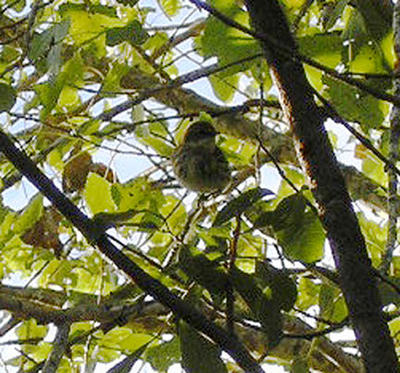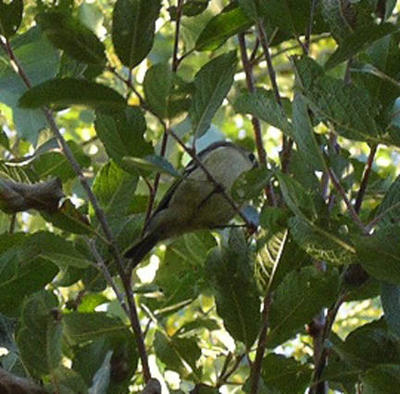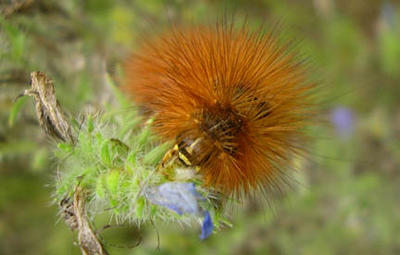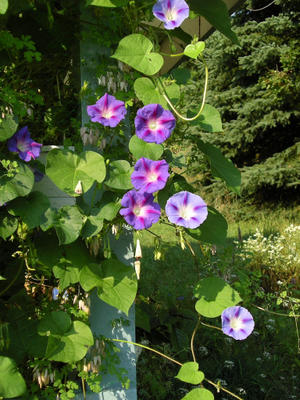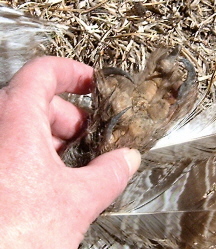Early last spring, one fine cool morning, I was walking up towards the back property line--a row of trees, some living, many dead, and a profusion of wild grape. I paused to see, not ten metres away, a raptor, sitting in clear view on the branch of a dead tree, probably less than 3 metres above the ground. The bird sat for a good long moment, so I could get a good long look, and I had no idea what it was. After the moment it flew away, giving me another nice clear view, and I went back to the house, determined to identify this bird.
My ability to identify raptors is still in infancy. I know a few, some because of lots of sightings, others because of great field marks. I, for example, can identify a mature bald eagle at great distance. I know this bird both by familiarity--I've spent time on BC's west coast where they are now extremely numerous--and of course field marks. We have a few around here, I see one about once a year (click
here for my 2005 sighting). I am also pretty good at picking out a red-tailed hawk, a very common bird around here, year round; the American kestrel is also common during the breeding season, and I can usually identify it--good field marks too; merlin, not bad, there are lots of this bird in Edmonton, where I lived for four years, and a few around here; osprey, good field marks; northern harrier, good field marks and I am pretty familiar with this bird too--then there are all those other ones, accipters, buteos, falcons--I might be able to place a bird in its group, but unless I get an awfully good look, with a field guide in my hand, I'm not up to much more.
So, did I identify that bird last spring? Sadly, yes. It was on the list of raptors that I do know--it was a
northern harrier. The problem was that it looked so much smaller than a harrier should look that I'd dismissed that as a possibility. Luckily the northern harrier has such good field marks; white bum, easily seen as it flies away; dihedral flight, facial disks, and this was a male with grey plumage, that through a process of elimination I was able to convince myself that I'd judged the size completely wrongly. Why did it look so small to me? No good frame of reference, an odd shape of land, and who knows why else.
I was thinking about this because this is the time of year that I might see many raptors. Thomasburg is not on a flight path where one might see hundreds, but we are close enough that through the early fall one can expect to see at least one migrant raptor everyday. Yesterday, I walked out of the house to see one sitting on a branch of the elm tree by the driveway that died this summer. A nice clear view of a clear white-breasted bird with a banded tail, well-defined bands. And that's all I got--from the sight of it sitting and it flying away. I had no binoculars, so the bands thing is just the impression at a distance.
Juvenile
broad-winged hawk (15") fits pretty well--and this is a bird that is common around here. But it might also have been a
Swainson's (19") I guess, though they aren't all that common. Then there's the
ferruginous (23"), not common at all, in fact a species at risk...and the red-tailed (19") that I know so well actually comes in a wide variety of morphs, some of which have almost white breasts.
Now 15" seems about right for the bird I saw, i.e., bigger than a blue jay, but not all that big--I doubt this could have been a 23" tall bird (forgive the imperial measures--I'm taking it out of
Sibley's, and anyway, I'm old enough that I was raised with imperial measures). But then I think of the harrier, 18" high, and how I was sure I was looking at about a 14" bird!
The Canadian Peregrine Foundation has a page
here to help with raptor identification. I'll be checking it out--and maybe this coming year will be my "raptor" year--there are so few compared to the warblers, I should be able to get this thing beat.
But here's another predator puzzle--last winter a northern shrike flew into the snowball bush in front of the house and sent all the feeder birds into a tizzy. It took me moments longer than it took them to see that the bird was a shrike--they knew instantly, I thought it was a blue jay at first. I've wondered ever since how it is that these tiny birds (chickadees, goldfinches, house finches, etc.), with their tiny brains, have the ability to recognize the shrike as a predator, when it provides none of the raptor cues.






